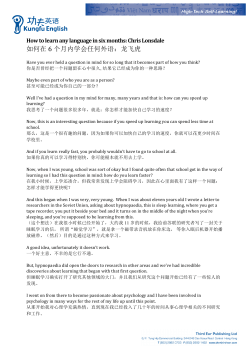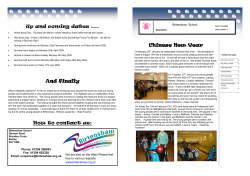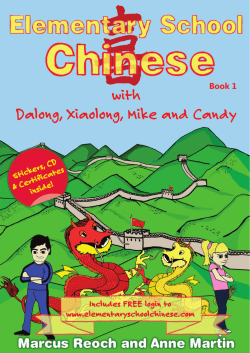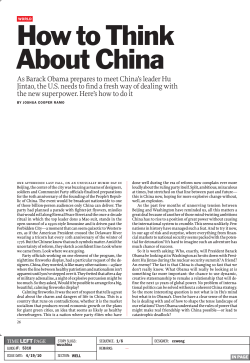
This article was downloaded by: [Kunming Institute of Botany], [Zhu... On: 14 March 2013, At: 22:15
This article was downloaded by: [Kunming Institute of Botany], [Zhu L. Yang] On: 14 March 2013, At: 22:15 Publisher: Taylor & Francis Informa Ltd Registered in England and Wales Registered Number: 1072954 Registered office: Mortimer House, 37-41 Mortimer Street, London W1T 3JH, UK Mycology: An International Journal on Fungal Biology Publication details, including instructions for authors and subscription information: http://www.tandfonline.com/loi/tmyc20 What is the Chinese “Lingzhi”? – a taxonomic minireview a Zhu L. Yang & Bang Feng a a Key Laboratory of Biodiversity and Biogeography, Kunming Institute of Botany, Chinese Academy of Sciences, Kunming, 650204, China Version of record first published: 07 Mar 2013. To cite this article: Zhu L. Yang & Bang Feng (2013): What is the Chinese “Lingzhi”? – a taxonomic mini-review, Mycology: An International Journal on Fungal Biology, DOI:10.1080/21501203.2013.774299 To link to this article: http://dx.doi.org/10.1080/21501203.2013.774299 PLEASE SCROLL DOWN FOR ARTICLE Full terms and conditions of use: http://www.tandfonline.com/page/terms-and-conditions This article may be used for research, teaching, and private study purposes. Any substantial or systematic reproduction, redistribution, reselling, loan, sub-licensing, systematic supply, or distribution in any form to anyone is expressly forbidden. The publisher does not give any warranty express or implied or make any representation that the contents will be complete or accurate or up to date. The accuracy of any instructions, formulae, and drug doses should be independently verified with primary sources. The publisher shall not be liable for any loss, actions, claims, proceedings, demand, or costs or damages whatsoever or howsoever caused arising directly or indirectly in connection with or arising out of the use of this material. Mycology, 2013 http://dx.doi.org/10.1080/21501203.2013.774299 What is the Chinese “Lingzhi”? – a taxonomic mini-review Zhu L. Yang* and Bang Feng Key Laboratory of Biodiversity and Biogeography, Kunming Institute of Botany, Chinese Academy of Sciences, Kunming 650204, China Downloaded by [Kunming Institute of Botany], [Zhu L. Yang] at 22:15 14 March 2013 (Received 25 January 2013; final version received 5 February 2013) “Lingzhi” is a fungus found in China for about 2000 years, renowned for its immense values in traditional Chinese medicine and culture. This fungus was generally assigned to Ganoderma lucidum, a species originally described from the UK. In the mid-nineties of the twentieth century, molecular phylogenetic analyses indicated that collections named G. lucidum in East Asia were in most cases not conspecific with G. lucidum found in Europe. However, the scientific name for the “lingzhi” found in China remained unclarified ever since. To clarify the identity of this fungus, two groups of Chinese mycologists have simultaneously gathered morphological and molecular evidence. One group concluded that “lingzhi” belonged to G. sichuanense, a species which was collected from Sichuan, a province in southwestern China, while the other group stated that the “lingzhi” is an undescribed species and, thus, named it as G. lingzhi. Our molecular phylogenetic evidence showed that G. lucidum s. str. occurs not only in northwestern and northeastern China but also in the highlands of southwestern China, where it has been commercially cultivated. In other words, both G. lucidum s. str. and G. lingzhi occur in natural environments in China, where they have been cultivated. Due to the phenotypic plasticity and morphological stasis, DNA sequence data play a vital role in characterizing the species within the G. lucidum-complex. Because the internal transcribed spacer (ITS) sequence has been successfully generated only once from the holotype of G. sichuanense, it suggests that the DNA in the holotype might have been largely digested. To settle the disputation and to clarify the relationships and taxonomic issues among G. lingzhi, G. sichuanense, G. sinense and other species in the complex, an epitype for G. sichuanense and for G. sinense from their type locality should be selected, and nucleotide sequences of more informative DNA markers should be used to delimit the species in the complex in the near future. In view of its economic, medicinal and cultural importance, the widely cultivated G. lingzhi is nominated as the fungus of the year (2013) for the journal Mycology. Keywords: epitype selection; Ganoderma; lingzhi; taxonomy; nomenclature “Lingzhi” (Ling-zhi) is a fungus found in China for about 2000 years, renowned for its values in traditional Chinese medicine and culture (Anonymous 102–200 AD/1955). With the development of science and technology, the medicinal properties of lingzhi, including cancer treatment, have been revealed (Ying et al. 1987; Jong & Birmingham 1992; CPC 2000; Paterson 2006), and commercial production of basidiocarps, basidiospores and mycelia of lingzhi has increased dramatically over the last few decades both within and outside China (Chang 2004). In view of the economic, medicinal and cultural importance of the species, it is herein nominated as the fungus of the year (2013) for the journal Mycology. Lingzhi together with the caterpillar fungus, Ophiocordyceps sinensis (Zhang et al. 2012), are the most well-known representatives of Chinese medicinal fungi. The “lingzhi” fungus was generally assigned to the scientific binomial Ganoderma lucidum (Curtis) P. Karst. by Chinese mycologists (Teng 1963; Liu 1974; Tai 1979; Ying et al. 1987; Zhao & Zhang 2000), although the Chinese term “lingzhi” may embrace more than one *Corresponding author. Email: fungi@mail.kib.ac.cn © 2013 Mycological Society of China forms or even distinct species in the traditional Chinese medicine and culture (CPC 2000; Zhao & Zhang 2000; Yu & Shen 2003). In fact, it is clearly indicated in “Pharmacopoeia of People’s Republic of China 2000 edition (part one)” that the general term “lingzhi” covers both “chizhi (G. lucidum)” and “zizhi (G. sinense J.D. Zhao et al.)” (CPC 2000). Ganoderma lucidum is a species originally described from England (Moncalvo & Ryvarden 1997). It is relatively common in Europe but its geographic distribution in other parts of the world is largely unknown (Moncalvo et al. 1995; Postnova & Skolotneva 2010). Molecular phyllogenetic analyses based on the ITS and 25S ribosomal DNA sequences indicated that most of the collections named as “G. lucidum” in East Asia were not conspecific with G. lucidum found in Europe. However, G. lucidum s. str. was shown to occur in northwestern China, as indicated by the presence of the Chinese collection Zhang 0981 (as “G. tsugae”) (Moncalvo et al. 1995). Moncalvo et al. (1995) stated that the name of a species restricted to East Asia (as “group 4”) needs to be determined. Without Downloaded by [Kunming Institute of Botany], [Zhu L. Yang] at 22:15 14 March 2013 2 Z.L. Yang and B. Feng further clarification, the Chinese “lingzhi” has continuously been referred to the name G. lucidum in the monographic works on Ganodermataceae in China (Zhao 1989; Zhao & Zhang 2000). Hawksworth (2005) proposed to conserve the name G. lucidum to an Asian type and introduce a new name for the European species. In the last few years, two groups of Chinese mycologists have gathered both morphological characters and molecular phylogenetic data in order to discuss the identity of “lingzhi”. Both groups worked independently on the same target taxon and published their findings, which were different, at almost the same time. Based on the rich collections, including cultivated basidiomata of “lingzhi”, detailed morphological observations and a multi-locus phylogenetic analysis, the research group led by Dr. Y.-J. Yao concluded that the species represented as “group 4” by Table 1. Moncalvo et al. (1995) was the Chinese lingzhi and morphological characters found in the holotype of G. sichuanense J.D. Zhao & X.Q. Zhang, originally described from Sichuan, southwestern China (Zhao et al. 1983), matched well with the characters of “lingzhi”, and, thus, “lingzhi” should be assigned to G. sichuanense (Wang et al. 2012). Unfortunately, the DNA sequences of the holotype of G. sichuanense were not successfully generated and, thus, could not be involved in the phylogenetic analysis. An ITS sequence from the holotype of G. sichuanense was eventually produced in the research group led by Dr. S.H. Wu and Dr. Y.C. Dai, who claimed that the “lingzhi”, including the strains of “group 4” of Moncalvo et al. (1995), was a hitherto undescribed species, and, thus, the name G. lingzhi Sheng H. Wu, Y. Cao & Y.C. Dai was proposed (Cao et al. 2012). New ITS sequences of Ganoderma generated and used in our phylogenetic analysis. Taxon Voucher Collector (no.) G. lingzhi HKAS76642 T. Guo (613) G. lucidum HKAS76455 Z. L. Yang (5656) G. lucidum G. lucidum HKAS71088 HKAS48969 Z. L. Yang (5603) Z. W. Ge (473) G. lucidum HKAS76643 Q. Zhao (1748) G. sp. G. tropicum HKAS76303 HKAS76644 Y. J. Hao (645) B. Feng (1254) (A) (B) (C) (D) Figure 1. Basidiomata of three species of Ganoderma lucidum complex in southwestern China. (A) Ganoderma lucidum (HKAS 76455 cultivated in Yunnan). (B) Ganoderma sp. (HKAS 76303 collected from Sichuan). (C) Ganoderma lucidum (HKAS 71088 collected from Yunnan). (D) Ganoderma lingzhi (HKAS 76642 collected from Yunnan). Figure 1B and 1D by courtesy of Y.J. Hao and T. Guo respectively. Locality Xishan Mt., Kunming, Yunnan Province, China Cultivated sample from Kunming, Yunnan Province, China Yeyahu, Kunming, Yunnan Province, China Yele Nature Reserve, Mianning County, Sichuan Province, China Ailao Mt., Jingdong County, Yunnan Province, China Dechang County, Sichuan Province, China Shitoushan, Xinzhu County, Taiwan, China Accession No. (ITS) KC222318 KC222320 KC222321 KC222322 KC222323 KC222319 KC222317 Figure 2. Microscopic features of three species of Ganoderma lucidum complex in China. (A)–(C) Pileipellis, basidiopsores, and basidia at different stages of development of G. lucidum (HKAS 76455). (D)–(E) Pileipellis and basidiopsores of G. sp. (HKAS 76303). (F) Basidiospores of G. lingzhi (isotype, IFP). 3 Downloaded by [Kunming Institute of Botany], [Zhu L. Yang] at 22:15 14 March 2013 Mycology Figure 3. Phylogenetic tree inferred from the Maximum Likelihood analysis based on the ITS dataset. Bootstrap values (>50%)/posterior probabilities from Bayesian Inference (>0.90) are shown above or beneath individual branches. Sequences of ITS generated in this study are marked with bold characters. Protocols for DNA extraction, PCR, cloning, sequencing and sequence alignment and molecular analysis followed those in Feng et al. (2012) and references therein. Previous molecular phylogenetic data showed that G. lucidum s. str. occurs in northwestern China and northeastern China (Moncalvo et al. 1995; Cao et al. 2012). By combining some ITS sequences generated from samples gathered from southwestern China, mainly from Yunnan and Sichuan provinces (Table 1), with the representative Downloaded by [Kunming Institute of Botany], [Zhu L. Yang] at 22:15 14 March 2013 4 Z.L. Yang and B. Feng sequences used in Moncalvo et al. (1995), Cao et al. (2012) and Wang et al. (2012), our analysis extends the distribution range of G. lucidum s. str. from temperate Eurasia (Europe, northwestern and northeastern China) to Sichuan and Yunnan provinces, southwestern China. Based on our field observations, G. lucidum s. str. is relatively common in highlands of southwestern China. It is worthy to note that G. lucidum s. str. has commercially been cultivated for medicinal purpose by the local residents in Kunming (Figures 1–3). Meanwhile, our analysis indicates that the taxonomy and nomenclature of the group of G. resinaceum Boud. still needs to be further addressed with a more comprehensive work. Due to phenotypic plasticity and morphological stasis (Steyaert 1972; Ryvarden 1991), DNA sequence data play an important or even an indispensible role to characterize fungal species (Yang 2011), especially the species within a species complex like the G. lucidum-complex. Because the ITS sequence has been successfully generated only once from the holotype of G. sichuanense after repeated failed attempts (Cao et al. 2012; Wang et al. 2012, personal communications), it suggests that the DNA in the holotype might have been largely digested. To settle the disputation and to clarify the relationship and taxonomic issues among G. lingzhi, G. sinense, G. sichuanense, G. weberianum and other species in the complex, an epitype for G. sinense, G. sichuanense or G. weberianum from their type locality is badly needed. In addition, it should be noted that the European G. lucidum often has a brick-red cap, a white context and becomes very light in weight when dried (Moncalvo, personal communication), while the Chinese G. lucidum samples studied in the present work have a purplish red to reddish brown cap, a dirty white context (Fig. 1A and 1C) and becomes light when dried. Such minor discrepancies might indicate that the European and the Chinese samples of G. lucidum s. str. represent different species which cannot be distinguished from ITS sequences alone. In the near future, nucleotide sequences of more informative DNA markers should be used to delimit the species in the complex. Acknowledgments The authors are very grateful to Dr. Y. Cao, Institute of Applied Ecology, Chinese Academy of Sciences (CAS), for sending them the isotype of G. lingzhi on loan, and to Ms. Y.J. Hao and Mr. Q. Zhao, Kunming Institute of Botany of CAS, for providing materials and photos of G. lingzhi and G. lucidum cultivated in Kunming. The authors thank Dr. J.-M. Moncalvo, Department of Natural History, Royal Ontario Museum, Canada, very much for the critical reading of the manuscript. This study was supported by the Hundred Talents Program of the Chinese Academy of Sciences, and by the National Natural Science Foundation of China (No. 31170024). References Anonymous. 102–200AD/Reprinted in 1955. Shen-Nong Materia Medica. Beijing: People’s Hygiene Press; 514 p. (in Chinese). Cao Y, Wu SH, Dai YC. 2012. Species clarification of the prize medicinal Ganoderma mushroom “Lingzhi”. Fungal Divers. 56:49–62. Chang ST. 2004. Ganoderma lucidum–a leader of edible and medicinal mushrooms. Int Agri Trade. 90:22–24. [CPC] China Pharmacopoeia Committee. 2000. Pharmacopoeia of People’s Republic of China 2000 edition (Part one). Beijing: Chemical Industry Press; 637 p. Feng B, Xu J, Wu G, Hosen MI, Zeng NK, Li YC, Tolgor B, Kost GW, Yang ZL. 2012. DNA sequence analyses reveal abundant diversity, endemism and evidence for Asian origin of the Porcini mushrooms. PLoS one. 7(5):e37567. Hawksworth DL. 2005. Reflections on changing names and related nomenclatural issues in edible and medicinal mushrooms. Int J Med Mushrooms. 7:29–38. Jong SC, Birmingham JM. 1992. Medicinal benefits of the mushroom Ganoderma. Adv Appl Microbiol. 37:101–134. Liu B. 1974. The Chinese medical fungi. Taiyuan: Shanxi People’s Press; 196 p. (in Chinese). Moncalvo J-M, Ryvarden L. 1997. A nomenclatural study of the Ganodermataceae Donk. Syn Fung. 11:1–114. Moncalvo J-M, Wang HF, Hseu RS. 1995. Gene phylogeny of the Ganoderma lucidum complex based on ribosomal DNA sequences: comparison with traditional taxonomic characters. Mycol Res. 99:1489–1499. Paterson RRM. 2006. Ganoderma–a therapeutic fungal biofactory. Phytochemistry. 67:1985–2001. Postnova EL, Skolotneva ES. 2010. Ganoderma lucidum complex: some individual groups of strains. Microbiology. 79:270–276. Ryvarden L. 1991. Genera of polypores. Nomenclature and taxonomy. Oslo: Fungiflora; 363 p. Steyaert RL. 1972. Species of Ganoderma and related genera mainly of the Bogor and Leiden herbaria. Persoonia. 7:55–118. Tai FL. 1979. Sylloge fungorum sinicorum. Beijing: Science Press; 1527 p. (in Chinese). Teng SC. 1963. Fungi of China. Beijing: Science Press, 808 p. (in Chinese). Wang XC, Xi RJ, Li Y, Wang DM, Yao YJ. 2012. The species identity of the widely cultivated Ganoderma, ‘G. lucidum’ (Ling-zhi), in China. PLoS one. 7(7):e40857. Yang ZL. 2011. Molecular techniques revolutionize knowledge of basidiomycete evolution. Fungal Divers. 50:47–58. Ying JZ, Mao XL, Ma QM, Zong YC, Wen HA. 1987. Icones of medicinal fungi from China. Beijing: Science Press; 579 p. (in Chinese). Yu YN, Shen MZ. 2003. The history of Lingzhi (Ganoderma spp.) cultivation. Mycosystema. 22(Suppl):3–9 (in Chinese). Zhang YJ, Li EW, Wang CS, Li YL, Liu XZ. 2012. Ophiocordyceps sinensis, the flagship fungus of China: terminology, life strategy and ecology. Mycology. 3:2–10. Zhao JD. 1989. The Ganodermataceae in China. Biblioth Mycol. 132:1–176. Zhao JD, Hsu LW, Zhang XQ. 1983. Taxonomic studies on the family Ganodermataceae of China II. Acta Mycol Sinica. 2:159–167. Zhao JD, Zhang XQ. 2000. Flora fungorum sinicorum (Vol. 18, Ganodermataceae). Beijing: Science Press; 204 pp. (in Chinese).
© Copyright 2025











